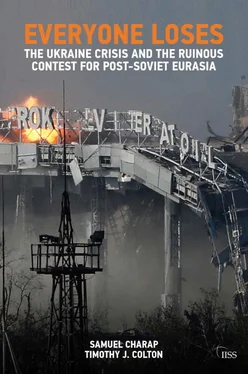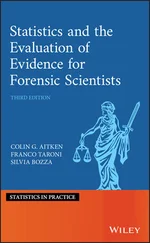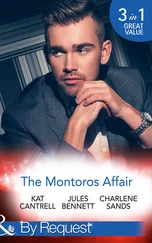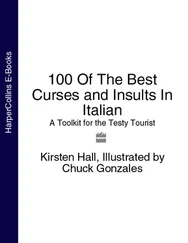The EU refused to back down. Barroso and the president of the European Council, Herman Van Rompuy, brought two copies of the AA to Vilnius in a last-ditch attempt to seal the deal in person with Yanukovych. [19] Ibid.
When even that could not deliver Yanukovych’s signature, European leaders publicly browbeat him during the evening reception, with the cameras rolling. These awkward moves created the distinct impression that motives other than reform and integration were driving EU policy. Washington, having observed the AA negotiations from the sidelines, was in no position to prevent this train wreck.
A few weeks after the meltdown at Vilnius, Putin received Yanukovych in Moscow to celebrate his apparent triumph over the EU. It was an enormously expensive victory: Russia promised to purchase US$15bn in Ukrainian eurobonds and to cut the gas price for Ukraine by more than US$130 per thousand cubic metres, or roughly one-third. At a press conference following the meeting, Putin said, ‘To reassure everyone: we did not discuss the issue of Ukraine joining the Customs Union.’ [20] ‘Zayavleniya dlya pressy po okonchanii zasedaniya Rossiisko-Ukrainskoi mezhgosudarstvennoi komissii’, 17 December 2013, http://kremlin.ru/events/president/transcripts/19854 .
Having pushed for full Ukrainian membership of the Customs Union several years earlier, Russia now was prepared to pay a high price just to block the EU agreement and keep the door open for the future.
Yanukovych’s calculus remains murky. Perhaps he never intended to sign the AA and simply wanted to garner as many concessions as possible from Russia. [21] Yanukovych allegedly met secretly with Putin three times in October–November in order to agree the details of the financial-support package, while still sending positive signals to the EU about Vilnius. See Sonya Koshkina, Maidan: Nerasskazannaya istoriya (Kyiv: Brait Star, 2015), p. 25.
A less cynical take is that he did want to go ahead with the AA – until Moscow made it clear that there would be a price to pay for doing so and the EU refused to pick up the tab. Despite the crudeness of Yanukovych’s horse-trading, his predicament was ultimately a product of zero-sum jousting between Russia and the EU, which led them to pose a binary choice to his country. Kyiv made plain that it did not want to choose, but was ignored. Even its public call for trilateral talks went unanswered until much later.
Russia’s victory was short-lived. Yanukovych returned from Moscow to find a large crowd occupying Kyiv’s central Maidan nezalezhnosti (Independence Square), the epicentre of the Orange Revolution in 2004. A group first gathered there in the days following Vilnius to protest Yanukovych’s about-face on the AA. But neither that agreement, a highly technical, 2,100-page document that mostly covers distinctly uninspiring subjects such as fishery regulations, nor even a desire to join the EU (supported by only 37% of the population at the time), would have produced the crowds that subsequently emerged. [22] International Foundation for Electoral Systems, ‘IFES Public Opinion in Ukraine 2013: Key Findings’, December 2013, http://pdf.usaid.gov/pdf_docs/pnaec646.pdf .
Had Yanukovych allowed those small, peaceful demonstrations to run their course, they would probably have petered out and the protesters returned home. However, his interior ministry moved to disperse the crowd forcefully; the riot police were particularly hard on students camped out on the square. The scenes of brutality inspired more than 500,000 people to take to the streets the next day. Despite the multitude of EU flags on display, the focus of the protests was now on ousting Yanukovych.
In the subsequent weeks, the government and a far-right nationalist vanguard among the protesters, who, unlike the peaceful majority of the diverse crowd, had taken up firearms, Molotov cocktails and improvised weapons, escalated the violence. As pandemonium unfolded in Kyiv, Russia and the West, reverting to type, sought to influence events to gain advantage in their contest over Ukraine, with both geo-economics and geopolitics now in play. The Kremlin pushed Yanukovych to crack down harder on the protesters. Its hand could be detected in a packet of repressive laws he rammed through parliament in mid-January, many of them modelled on analogous Russian legislation.
US and EU leaders and diplomats met with and called Yanukovych and his senior ministers dozens of times to urge them to compromise with the Western-leaning opposition and avoid mayhem on the Maidan. US officials were deeply involved in trying to forge a settlement to the crisis; a leaked recording of a conversation between two of them exposed an effort to pick which opposition politicians would sit in a new government. The officials tried to seal the deal, which in the end fell through, before Russia had time to react. [23] ‘Ukraine Crisis: Transcript of Leaked Nuland–Pyatt Call’, BBC News, 7 February 2014, http://www.bbc.com/news/world-europe-26079957 .
Given that the recording was, in all likelihood, made and leaked by Russian operatives, it is safe to assume that the Kremlin believed the US was mounting another regime-change operation, that is, regional geopolitics as usual. Brussels tried to take advantage of the pro-EU leanings of the protesters, mounting a rearguard action to give Yanukovych another chance to sign the AA (on the premise that doing so would satisfy the crowds), and this time dangling the financial assistance it had denied him two months earlier. [24] Koshkina, Maidan , p. 165; ‘EU Mulls Aid Package for Crisis-Ridden Ukraine’, Associated Press, 3 February 2014, http://bigstory.ap.org/article/eu-mulls-aid-package-crisis-ridden-ukraine .
Another settlement-that-wasn’t
After a particularly gory series of clashes between protesters and police that left dozens dead in mid-February 2014, the Ukrainians and the outside powers took a step back from the abyss. Talks between Yanukovych and the nominal leaders of the Maidan protest movement – it would become clear later that they were not in fact leading the crowds, but being led by them – began in earnest. During three days of negotiations, Yanukovych and three opposition leaders – Oleh Tyahnybok, Vitaliy Klichko and Arseniy Yatsenyuk – hammered out an agreement mediated by the French, Polish and German foreign ministers and a Russian presidential representative. Signed on 21 February, the pact stated that the 2004 amendments to the constitution, which placed limits on the president’s powers and had been revoked in 2010, would be restored within 48 hours; a national unity government would be formed within ten days; all illegal weapons were to be surrendered; presidential elections would be held under reformed electoral laws no later than December 2014; and the occupations of streets and buildings would end. [25] The agreement is available at http://zn.ua/POLITICS/obnarodovan-tekst-soglasheniya-ob-uregulirovanii-krizisa-v-ukraine-139374_.html .
Participants reported that Putin called Yanukovych during the talks to urge him to agree to the deal. [26] Mick Krever, ‘Putin Phone Call Convinced Yanukovych to Change Attitude, Says Polish Foreign Minister’, Amanpour Blog, CNN, 26 February 2014, http://amanpour.blogs.cnn.com/2014/02/26/vladimir-putin-viktor-yanukovych-radoslaw-sikorski-ukraine-poland-russia/ .
In what looked like a Russia–West truce, Putin and US President Obama spoke on the phone that night and agreed on the need to implement the arrangement in full and without delay. [27] ‘Readout of President Obama’s Call with President Putin’, 21 February 2014, https://www.whitehouse.gov/the-press-office/2014/02/21/readout-president-obama-s-call-president-putin .
On paper, the 21 February agreement had elements of a ‘pacted’ transition, a form of political transformation that is generally more peaceful and democratic than forcing incumbents out of office. It also had the benefit of endorsement by the external powers that had spent much of the previous six months locked in a tug of war over Ukraine.
Читать дальше











